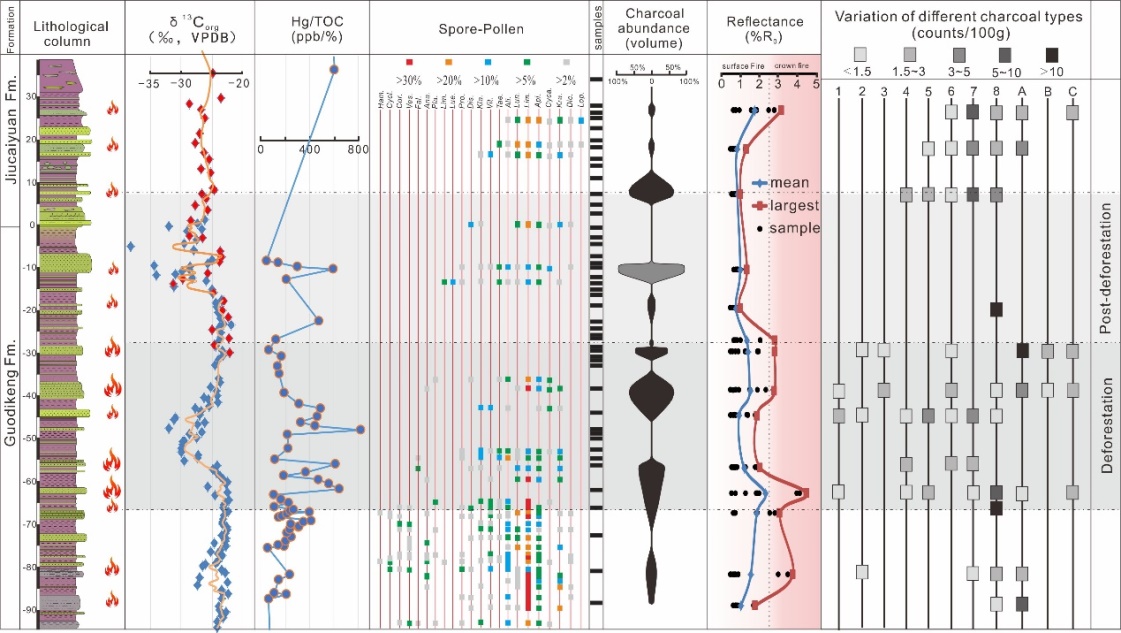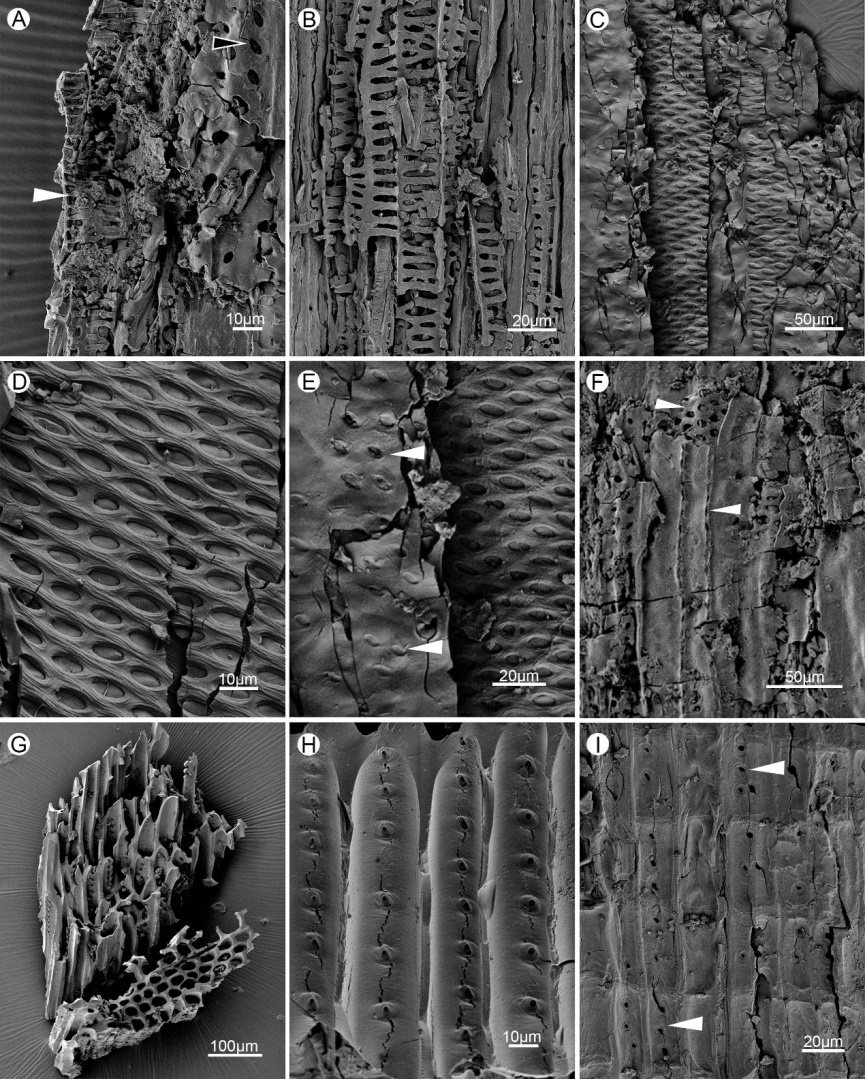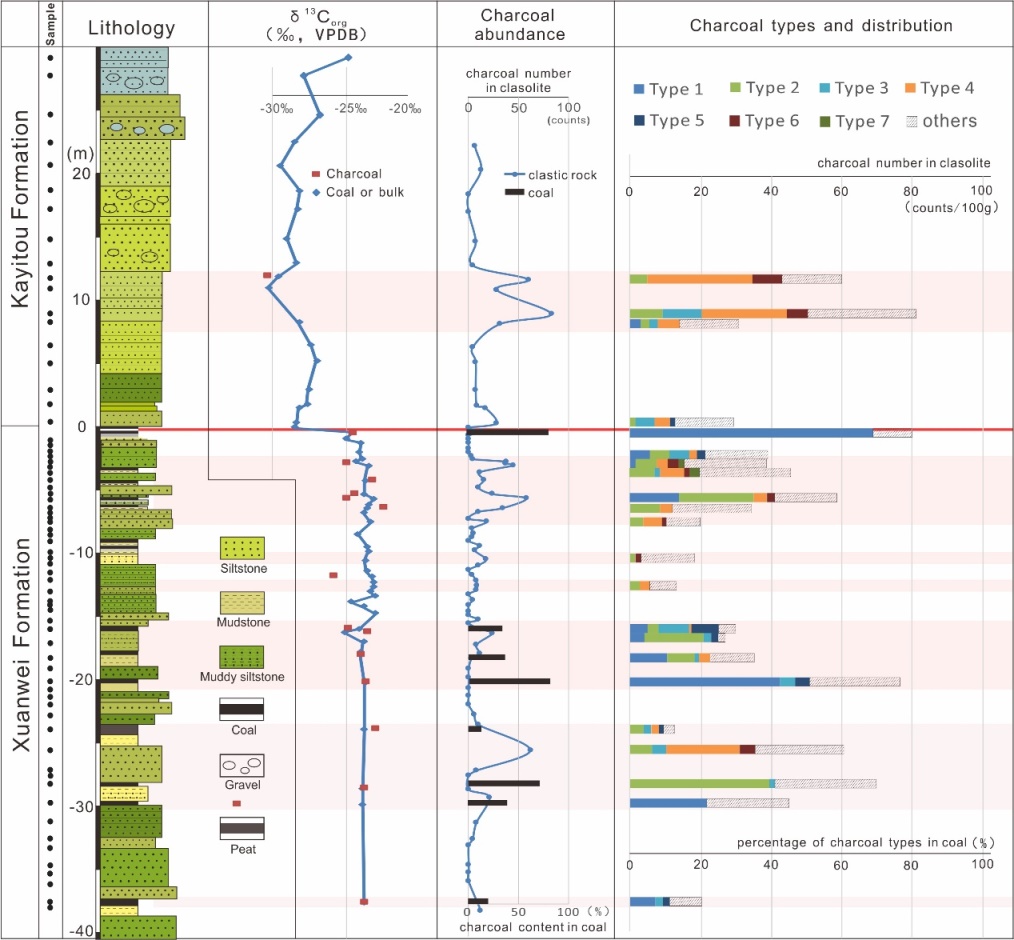Volcanic activity drove an increase in the intensity of wildfire events, which in turn disturbed and affected terrestrial ecosystem.
Wildfire is an important part of terrestrial ecosystem. It plays a significant role in many environmental and evolutionary innovations in geological history. The End-Permian mass extinction is the biggest extinction event in Earth's history, and the response of terrestrial vegetation systems to this event has been highly concerned in recent years. Nowadays more and more records of wildfire are reported from the Late Paleozoic, the investigations focusing on wildfire are of great significance to learn the collapse of terrestrial ecosystem and the vegetation changeover during the Permian-Triassic transition.
Recently, the Late Paleozoic research group from Nanjing Institute of Geology and Palaeontology, Chinese Academy of Sciences (NIGPAS), Nanjing University and Yunnan University, carried out a systematic studies focused on charcoals and δ13Corg from the upper Permian of the Dalongkou section in Xinjiang Uygur Autonomous Region and of the Lengqinggou section in Guizhou, Southwest China. The results were published on Earth-Science Reviews and Frontiers in Earth Science.
In Dalongkou section, charcoals from several stratigraphic horizons in the lower-middle Guodikeng Formation evidenced the frequency of palaeo-wildfires during the late Permian. The reflectance values of the charcoals indicate that surface fires were dominant throughout the sequence, with fire regime changing in the upper of the Guodikeng Formation from higher reflectance to extremely low reflectance. It probably hints at a vegetational impoverishment and the lack of fuel during that time. The distribution of all categories of the charcoals, the difference of cuticles and the evidence of spore-pollen also support the deforestation stage. In addition, the coupling of the Hg/TOC peaks and the organic carbon isotope (δ13Corg) values and the abundance of the charcoals in the sequence indicates that volcanic activities could be the deep-seated drivers for wildfires and the δ13Corg change.
The work of Lengqinggou section shows that charcoals from the Xuanwei Formation occurred more frequently, with higher reflectance and diversity, while that from the Kayitou Formation exhibit low reflectance and diversity. This phenomenon supports the point that the vegetation had changeover from rainforest to herb land between the two formations. Meanwhile, the fire regime also changed from high temperature crown fire to the ground fire with lower temperature. Furthermore, an ash bed in the uppermost coal in the Xuanwei Formation was concerned. Detailed sampling shows that an abrupt excursion of δ13Corg and reduction of charcoal abundance occurred immediately above the volcanic ash. It suggests that the intensive wildfire associated with volcanism culminated at that time, leading to the eventual vegetation changeover of the terrestrial ecosystems in Southwest China during the Permian-Triassic transition.
The works were supported by the Strategic Priority Research Programs (B) of the Chinese Academy of Sciences and the National Natural Science Foundation of China and CAS.
Related Article:
Cai, Y.F., Zhang, H. *, Cao C.Q., Zheng, Q.F., Jin, C.F., Shen, S.Z., 2021. Wildfires and deforestation during the Permian–Triassic transition in the southern Junggar Basin, Northwest China. Earth-Science Reviews 218 (7): 103670. DOI: 10.1016/j.earscirev.2021.103670
Cai, Y.F., Zhang, H. *, Feng, Z., Shen, S.Z., 2021. Intensive wildfire associated with volcanism promoted the vegetation changeover in Southwest China during the Permian-Triassic transition. Frontiers in Earth Science. 9:615841. https://doi.org/10.3389/feart.2021.615841

SEM images of charcoal from the Dalongkou section in Xinjiang Uygur Autonomous Region, Northwest China

Co-variation diagrams for the δ13Corg values, Hg/TOC values, charcoal abundance, reflectance and types of fossil charcoal in the Dalongkou section

SEM images of charcoal from the Lengqinggou section in Guizhou Province, Southwest China

Contact:
LIU Yun, Propagandist
Email: yunliu@nigpas.ac.cn
Nanjing Institute of Geology and Palaeontology, Chinese Academy of Sciences
Nanjing, Jiangsu 210008, China
Download:
